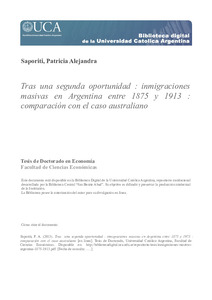Please use this identifier to cite or link to this item:
https://repositorio.uca.edu.ar/handle/123456789/151| Título: | Tras una segunda oportunidad : inmigraciones masivas en Argentina entre 1875 y 1913 : comparación con el caso australiano | Autor: | Saporiti de Baldrich, Patricia Alejandra | Director de Tesis: | Cortés Conde, Roberto, 1932- | Palabras clave: | INMIGRACION; INMIGRANTES; ECONOMIA | Fecha de publicación: | 2013 | Cita: | Saporiti, P. A. (2013). Tras una segunda oportunidad : inmigraciones masivas en Argentina entre 1875 y 1973 : comparación con el caso australiano [en línea]. Tesis de Doctorado, Universidad Católica Argentina, Facultad de Ciencias Económicas. Disponible en: https://repositorio.uca.edu.ar/handle/123456789/151 | Resumen: | Introducción: El objetivo de la presente tesis es analizar los principales determinantes económicos de los ingresos masivos de migrantes europeos en Argentina y Australia entre 1875 y 1913, identificando además factores institucionales y geográficos que pudieron haber influido en tal decisión. Al profundizar en el estudio de la historia económica, el análisis meramente vertical, cronológico, debe complementarse con otro de corte horizontal, que contempla comparaciones, conexiones y coyunturas globales que rodean y afectan la evolución de las variables analizadas... Abstract: The aim of this thesis is to examine the economic determinants of mass migrations to Argentina and Australia, between 1875 and 1913, and to identify some underlying geographic and institutional determinants. The structure of the thesis is as follows. First, I describe the 19 th century markets integration. In the second chapter, I surveyed the literature linking geography, institutions, development and migrations. Chapter three describes the development of greater labor markets and the expelling European experience. Chapter four provides an overview of Argentinean and Australian settlements, including geographical characteristics, such as distance and agricultural aptitude, institutions development and economic performance from the middle of the 19 th century to 1913. In Chapter five I present a simple econometric model to examine aspects of immigration flows. The general hypothesis is that economic opportunities and immigrations institutions determine the arrivals. The analysis focuses on the evolution of relevant institutions, so I have constructed an immigrations policies index in order to capture the main local tendencies to either restrict and/ or attract migrants. The empirical evidence that emerges from estimating our migration model confirm the importance of economic opportunities (not restricted to wage gaps) and of government immigration policies, although our immigration institution index is inadequate for Australia, due to data limitations |
Cobertura Espacial: | 1875-1913 ARGENTINA AUSTRALIA |
URI: | https://repositorio.uca.edu.ar/handle/123456789/151 | Disciplina: | ECONOMIA | Derechos: | Acceso Abierto |
| Appears in Collections: | Tesis de Doctorado en Economía |
Show full item record
Page view(s)
1,150
checked on Dec 24, 2025
Download(s)
1,055
checked on Dec 24, 2025
Google ScholarTM
Check
This item is licensed under a Creative Commons License


